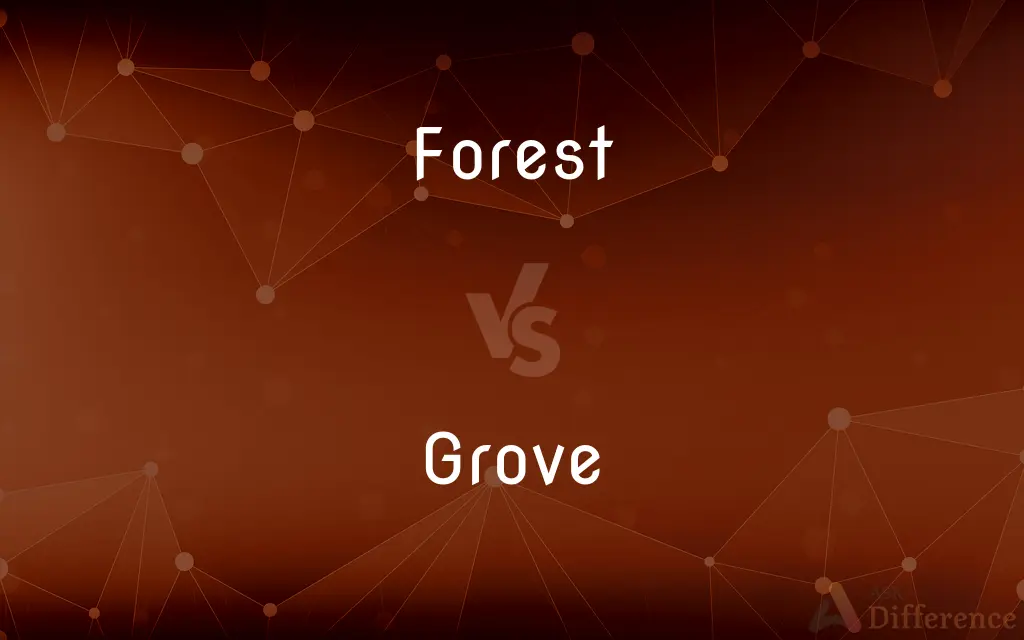Forest vs. Grove — What's the Difference?
Edited by Tayyaba Rehman — By Fiza Rafique — Updated on March 21, 2024
A forest is a large area covered with trees and underbrush, while a grove is a smaller group of trees without dense underbrush.

Difference Between Forest and Grove
Table of Contents
ADVERTISEMENT
Key Differences
A forest is characterized by its extensive land area covered with a dense collection of trees and undergrowth, often serving as a habitat for a wide variety of wildlife. In contrast, a grove is a smaller, more open grouping of trees, typically without much undergrowth, sometimes found within a forest or as a standalone feature in a landscape.
Forests play a crucial role in the Earth's ecological balance, including carbon sequestration, oxygen production, and biodiversity support. Groves, while smaller, can still provide ecological benefits such as habitat for certain wildlife, but their impact is more localized and less extensive compared to forests.
The term "forest" often implies a certain level of wildness or natural state, potentially including various ecosystems such as rainforests, boreal forests, and deciduous forests. On the other hand, groves are frequently associated with human cultivation or maintenance, such as orchards or landscaped areas, though they can also occur naturally.
In terms of usage, forests are critical for industries like lumber, paper, and non-timber forest products, besides being vital for ecological research and conservation efforts. Groves, due to their smaller size and often managed state, are more commonly associated with recreational, aesthetic, or agricultural purposes.
Despite their differences, both forests and groves contribute to the beauty and ecological diversity of the planet. They offer spaces for recreation, habitat for wildlife, and play roles in the global and local ecosystems, albeit on different scales and intensities.
ADVERTISEMENT
Comparison Chart
Size
Large, expansive areas
Smaller, more contained groupings
Undergrowth
Typically dense with underbrush and a variety of flora
Often sparse underbrush, if any
Ecological Impact
Significant, contributing to global biodiversity and climate regulation
More localized, with specific ecological or aesthetic contributions
Association
Wildness, natural state, various ecosystems
Human cultivation or maintenance, sometimes natural
Usage
Lumber, paper, conservation, ecological research
Recreation, aesthetic enjoyment, agriculture (orchards)
Compare with Definitions
Forest
Characterized by extensive tree coverage and dense undergrowth.
The Amazon Rainforest is a vast forest crucial for global biodiversity.
Grove
Typically a small, open cluster of trees without much underbrush.
A grove of olive trees might be found in a Mediterranean landscape.
Forest
Includes diverse types such as rainforests and boreal forests.
The Taiga represents the world's largest forest type, spanning the northern latitudes.
Grove
Frequently associated with human-planted orchards or gardens.
A grove of fruit trees may be cultivated for agricultural purposes.
Forest
Plays a critical role in carbon sequestration and biodiversity.
Forests are vital for sustaining a wide range of plant and animal species.
Grove
Some groves, like orchards, have significant agricultural value.
Apple groves provide valuable crops for the food industry.
Forest
Source of lumber, paper, and other forest products.
Forests are harvested for timber, crucial for the construction and paper industries.
Grove
Provides habitat and ecological benefits on a smaller scale.
A grove can offer an essential habitat for certain bird species.
Forest
Important areas for ecological research and conservation efforts.
Many forests are protected areas, studied for their ecological importance.
Grove
Groves are appreciated for their beauty and tranquility.
People may visit a grove for picnicking or leisurely walks.
Forest
A forest is an area of land dominated by trees. Hundreds of definitions of forest are used throughout the world, incorporating factors such as tree density, tree height, land use, legal standing and ecological function.
Grove
A small wood or stand of trees lacking dense undergrowth.
Forest
A large area covered chiefly with trees and undergrowth
A pine forest
A large tract of forest
Grove
A group of trees planted and cultivated for the production of fruit or nuts
An orange grove.
Forest
A large number or dense mass of vertical or tangled objects
A forest of high-rise apartments
Grove
A small forest.
Forest
Cover (land) with forest; plant with trees
A forested hillside
Grove
An orchard of fruit trees.
Forest
A growth of trees and other plants covering a large area.
Grove
A place of worship.
Forest
A large number of objects bearing a similarity to such a growth, especially a dense collection of tall objects
A forest of skyscrapers.
Grove
A lodge of the Ancient Order of Druids.
Forest
A defined area of land formerly set aside in England as a royal hunting ground.
Grove
To cultivate in groves; to grow naturally so as to form groves.
Forest
To plant trees on or cover with trees.
Grove
To cultivate with periodic harvesting that also serves to create order (gaps and lines of trees) to facilitate further harvesting.
Forest
A dense uncultivated tract of trees and undergrowth, larger than woods.
Grove
To plough or gouge with lines.
Forest
Any dense collection or amount.
A forest of criticism
Grove
A smaller group of trees than a forest, and without underwood, planted, or growing naturally as if arranged by art; a wood of small extent.
Forest
(historical) A defined area of land set aside in England as royal hunting ground or for other privileged use; all such areas.
Grove
A small growth of trees without underbrush
Forest
(graph theory) A graph with no cycles; i.e., a graph made up of trees.
Grove
Garden consisting of a small cultivated wood without undergrowth
Forest
A group of domains that are managed as a unit.
Forest
The colour forest green.
Forest
(transitive) To cover an area with trees.
Forest
An extensive wood; a large tract of land covered with trees; in the United States, a wood of native growth, or a tract of woodland which has never been cultivated.
Forest
A large extent or precinct of country, generally waste and woody, belonging to the sovereign, set apart for the keeping of game for his use, not inclosed, but distinguished by certain limits, and protected by certain laws, courts, and officers of its own.
Forest
Of or pertaining to a forest; sylvan.
Forest
To cover with trees or wood.
Forest
The trees and other plants in a large densely wooded area
Forest
Land that is covered with trees and shrubs
Forest
Establish a forest on previously unforested land;
Afforest the mountains
Common Curiosities
What ecological benefits do forests provide?
Forests contribute to carbon sequestration, oxygen production, climate regulation, soil conservation, and biodiversity support.
Are groves always man-made?
Not necessarily; while groves are often associated with human activity like orchards, natural groves can occur without human intervention.
How is a grove different from a forest?
A grove is a smaller, more defined grouping of trees, often with little to no underbrush, and can be either a natural feature or the result of human cultivation.
What types of ecosystems can be found in forests?
Forests can encompass a variety of ecosystems, including rainforests, deciduous forests, boreal forests, and more, each with unique flora and fauna.
Why are forests important for biodiversity?
Forests offer diverse habitats that support a wide range of plant and animal species, contributing significantly to global biodiversity.
What defines a forest?
A forest is defined by its large area covered densely with trees, underbrush, and various flora, often serving as a habitat for diverse wildlife.
Can a grove be part of a forest?
Yes, groves can exist within forests as smaller, distinct clusters of trees, sometimes with a unique or significant collection of tree species.
Can groves have any cultural significance?
Yes, groves can hold cultural, spiritual, or historical significance, often serving as the settings for communal, ceremonial, or reflective activities.
How do groves contribute to the environment?
Groves contribute by providing localized habitats, enhancing landscape aesthetics, and sometimes serving agricultural or recreational purposes.
What is the significance of groves in urban environments?
In urban areas, groves can provide green spaces for recreation, contribute to air purification, and enhance urban biodiversity.
How do deforestation and urbanization impact forests and groves?
Deforestation and urbanization can lead to habitat loss, biodiversity reduction, and negative impacts on climate and air quality, highlighting the need for sustainable development.
What role do humans play in the preservation of forests and groves?
Humans play a critical role in conserving and managing forests and groves, through sustainable practices, conservation efforts, and ecological research.
How do forests affect climate change?
Forests help mitigate climate change by absorbing carbon dioxide, a major greenhouse gas, thus playing a key role in climate regulation.
Are there any specific laws protecting forests?
Many countries have laws and regulations aimed at protecting forests, promoting sustainable management, and conserving biodiversity.
What measures can be taken to preserve forests and groves?
Preservation efforts can include establishing protected areas, promoting sustainable land use practices, reforestation, and public education on ecological values.
Share Your Discovery

Previous Comparison
Dreamer vs. Realist
Next Comparison
Advice vs. InsightAuthor Spotlight
Written by
Fiza RafiqueFiza Rafique is a skilled content writer at AskDifference.com, where she meticulously refines and enhances written pieces. Drawing from her vast editorial expertise, Fiza ensures clarity, accuracy, and precision in every article. Passionate about language, she continually seeks to elevate the quality of content for readers worldwide.
Edited by
Tayyaba RehmanTayyaba Rehman is a distinguished writer, currently serving as a primary contributor to askdifference.com. As a researcher in semantics and etymology, Tayyaba's passion for the complexity of languages and their distinctions has found a perfect home on the platform. Tayyaba delves into the intricacies of language, distinguishing between commonly confused words and phrases, thereby providing clarity for readers worldwide.














































